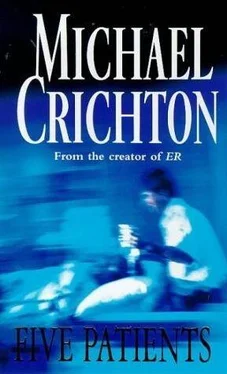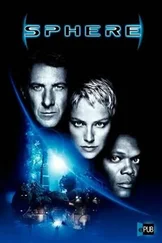Michael Crichton - Five Patients
Здесь есть возможность читать онлайн «Michael Crichton - Five Patients» весь текст электронной книги совершенно бесплатно (целиком полную версию без сокращений). В некоторых случаях можно слушать аудио, скачать через торрент в формате fb2 и присутствует краткое содержание. Жанр: Триллер, на английском языке. Описание произведения, (предисловие) а так же отзывы посетителей доступны на портале библиотеки ЛибКат.
- Название:Five Patients
- Автор:
- Жанр:
- Год:неизвестен
- ISBN:нет данных
- Рейтинг книги:5 / 5. Голосов: 1
-
Избранное:Добавить в избранное
- Отзывы:
-
Ваша оценка:
- 100
- 1
- 2
- 3
- 4
- 5
Five Patients: краткое содержание, описание и аннотация
Предлагаем к чтению аннотацию, описание, краткое содержание или предисловие (зависит от того, что написал сам автор книги «Five Patients»). Если вы не нашли необходимую информацию о книге — напишите в комментариях, мы постараемся отыскать её.
Five Patients — читать онлайн бесплатно полную книгу (весь текст) целиком
Ниже представлен текст книги, разбитый по страницам. Система сохранения места последней прочитанной страницы, позволяет с удобством читать онлайн бесплатно книгу «Five Patients», без необходимости каждый раз заново искать на чём Вы остановились. Поставьте закладку, и сможете в любой момент перейти на страницу, на которой закончили чтение.
Интервал:
Закладка:
phone.
Closed-circuit television, while far from the ideal of a personal examination, is vastly superior to the telephone alone, and in many cases it is surprisingly adequate. This does not mean that future patients will all be seen by closed-circuit television, with neither doctor nor patient leaving home. What it does mean is that television will probably work in certain very special applications. One of these is the Logan application-providing a doctor to a clinic during low-use periods. Another obvious use would be specialist consultations. A hospital or clinic that needs a neurologist only a few times a year cannot afford to staff one. Nor could it find one, even if it could afford it. Television is perfectly suited to such consultation.
At the same time, a system such as that at Logan makes possible a routine physical examination, but goes no further-and there are suggestions that technology will ultimately change the very nature of physical examination. Here the historical trend is clear.
Consider the innovations in physical diagnosis. In the nineteenth century, there were three of great importance-the stethoscope, the blood-pressure cuff, and the thermometer. Each of these is really nothing more than a precise way to determine what can be inaccurately determined by other means. Thus the thermometer is superior to the hand on the forehead; the stethoscope superior to the ear against the chest [For the purposes of this argument, I will ignore the fact that the stethoscope really initiated auscultation as a useful examination procedure. In truth, ears were not pressed against the chest with much regularity before Laennec invented the stethoscope and described auscultation.]; and the blood-pressure cuff superior to a finger compressing the artery to test its pressure.
Now, the first two advances of the twentieth century were quite different: the X ray and electrocardiogram provided new information not obtainable by physical contact. No amount of squeezing and touching the patient will tell you anything directly about the electrical currents in his heart. You may deduce this information from other findings, but you cannot extract it directly. Similarly, X rays represent a new kind of vision, providing a new kind of information.
At the present time a variety of examination procedures are being tested. These include ther-mography, ultraviolet light, ultrasonic sound, as well as mapping electrical currents in the skin. Except for thermography, these all represent "new" sensory information for the doctor.
Thus the initial trend was to measure the patient more exactly, and later, to measure the patient in new ways. The first approach has been to find new sorts of measurements and new sensory information. But a second approach, now in its infancy, concerns translation of old information into new forms. The computer will be helpful here in a number of ways, in producing what is called "derivative information."
In a simple way, this is already being done. The human computer [Defmed as the only computer that can be produced by unskilled labor] and the electrocardiogram are a clear example. The electrocardiogram measures electrical currents within the heart muscle-the current that makes it contract and beat. Often, when a physician looks at an electrocardiogram, he wants specific electrical information. He wants to know about rate and rhythm, about conduction of impulses, and so on. At other times, he wants nonelectrical information. He may want to know how thick a part of the heart wall is, for instance. In this case, he derives the information from the electrical information.
But there are more complex forms of derived in-
formation. A physician examining a patient with heart disease may be interested in knowing the cardiac output-exactly how much blood the heart is pumping per minute. This is the product of heart rate (easily determined) and volume of blood ejected per beat (very difficult to determine). Because cardiac output is so hard to assess, it is not much used in diagnosis and therapy. However, by measuring heart rate and the shape of the arterial pulse (both easily done) a computer can calculate cardiac output and can perform these calculations continuously over a period of days, if necessary. If a physician needs to know cardiac output, he can have this information. He can have it for as long as the patient is connected to the computer.
Does the physician really need cardiac output? At the moment, he can't be sure. For centuries he's had to content himself with other information. There is reason to believe, however, that cardiac output will be useful in a variety of ways, as will other derived information.
An interesting technological application concerns the reverse of the coin: determining which information the physician already has but does not need. This is not to say that the information is inaccurate, but only that it does not have diagnostic significance and is therefore not worth obtaining. At present, the physician naturally tries to avoid gathering useless information, but in certain circumstances he cannot perform as well as a computer. Multiple discriminant analysis is a case in point. As one observer notes, "There is a limita-
tion on the human mind regarding the speed, accuracy, and ability to correlate and intercorrelate multiple variables with all possible outcomes and treatment consequences." There is a limitation on the computer, too. Practically speaking, there are many limitations. But in purely mathematical capability, the human mind is much inferior to the computer in multiple-discriminant analysis.
This is a function vital to diagnosis. It refers to the ability to consider a large body of facts, and on the basis of those facts to assign a patient to one diagnostic category or another on the basis of probability. Consider a simple set of categories: appendicitis versus no-appendicitis. (This is a simplification of what is, practically speaking, a larger problem in diagnostic categories, but it will serve to explain the principle.) Let us assume that a surgeon seeing a patient with pain on the right side must make only this decision. How does he make it? No single piece of information will tell him the answer (except, perhaps, the fact of a previous appendectomy). Certainly such routine data as sex, age, white count, degree of fever, duration of pain in hours will not tell him. But considered all together, they permit him to arrive at a decision.
This is all very familiar. But the point is that it is not very precise. A discriminant function can be produced that weighs each variable-age, sex, white count-on the basis of how important each variable has been in the past. Thus the discriminant function has two uses. First, it can make a diagnosis and act as a consultant to the surgeon.* Second, it can determine which variables are most significant, which account for the greatest proportion of the variance, in making a diagnosis. This can sometimes be surprising. For example, one study of women undergoing gynecologic surgery indicated that the age of the patient had great diagnostic importance, and that notation of last menstrual period, biopsy of smear, pre-operative hemoglobin, and urine-sediment study were all much less important to making a diagnosis.
These applications of the computer are designed to be diagnostic aids to the doctor, rather than a replacement. One hears, for example, that "even though computers can be programmed to make diagnoses, it takes the physician to perform the physical examination, and it takes the personal contact of the doctor-patient relationship to gather the information needed for the identification process."
For better or worse, this is not quite true. History-taking, long the province of the physician and a keystone to his "art," is partially amenable to automation. The Logan station utilizes a simple program, which is not so much a conversation with the computer as a quiz. But more sophisticated programs exist, and still better ones are being planned.
Читать дальшеИнтервал:
Закладка:
Похожие книги на «Five Patients»
Представляем Вашему вниманию похожие книги на «Five Patients» списком для выбора. Мы отобрали схожую по названию и смыслу литературу в надежде предоставить читателям больше вариантов отыскать новые, интересные, ещё непрочитанные произведения.
Обсуждение, отзывы о книге «Five Patients» и просто собственные мнения читателей. Оставьте ваши комментарии, напишите, что Вы думаете о произведении, его смысле или главных героях. Укажите что конкретно понравилось, а что нет, и почему Вы так считаете.









